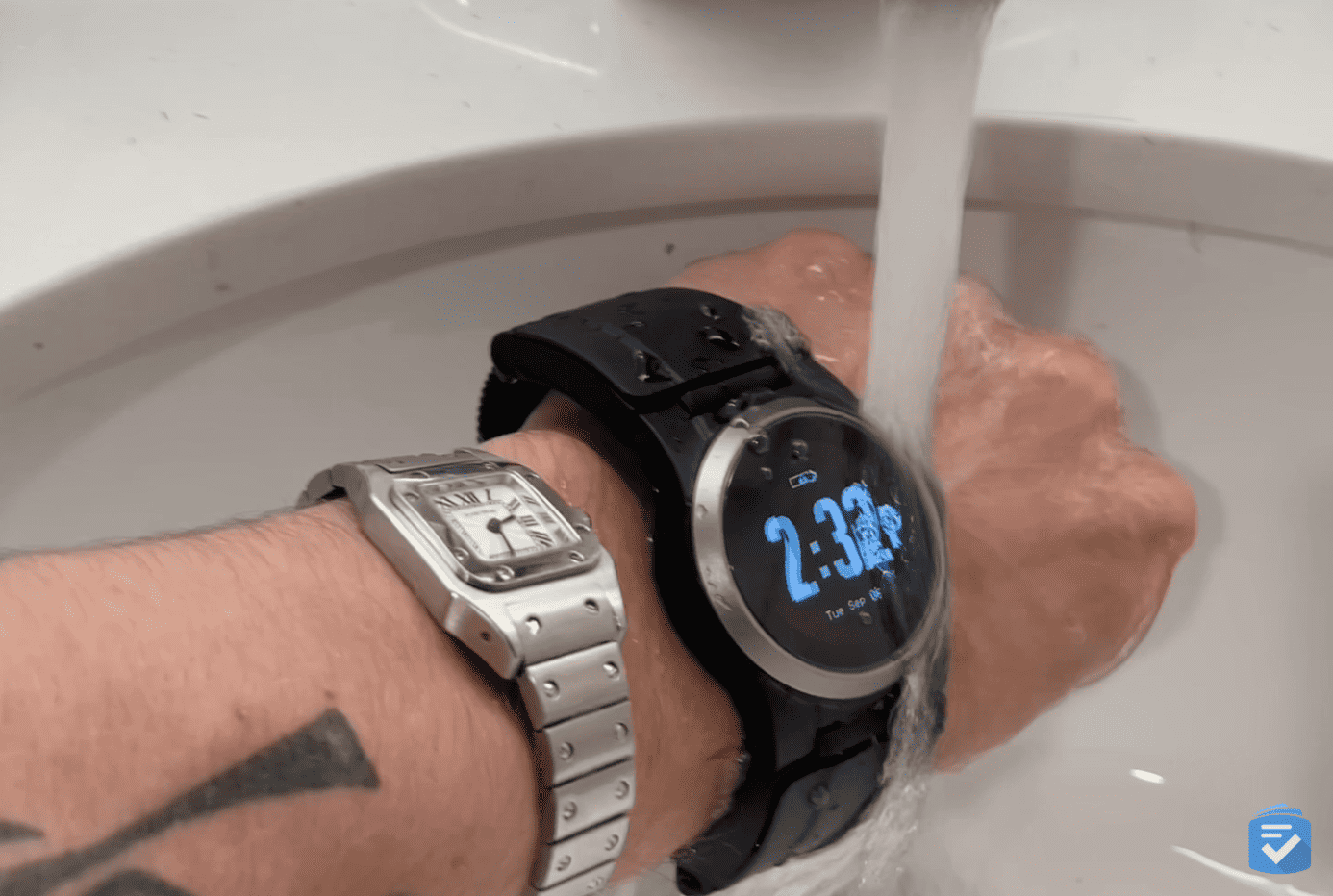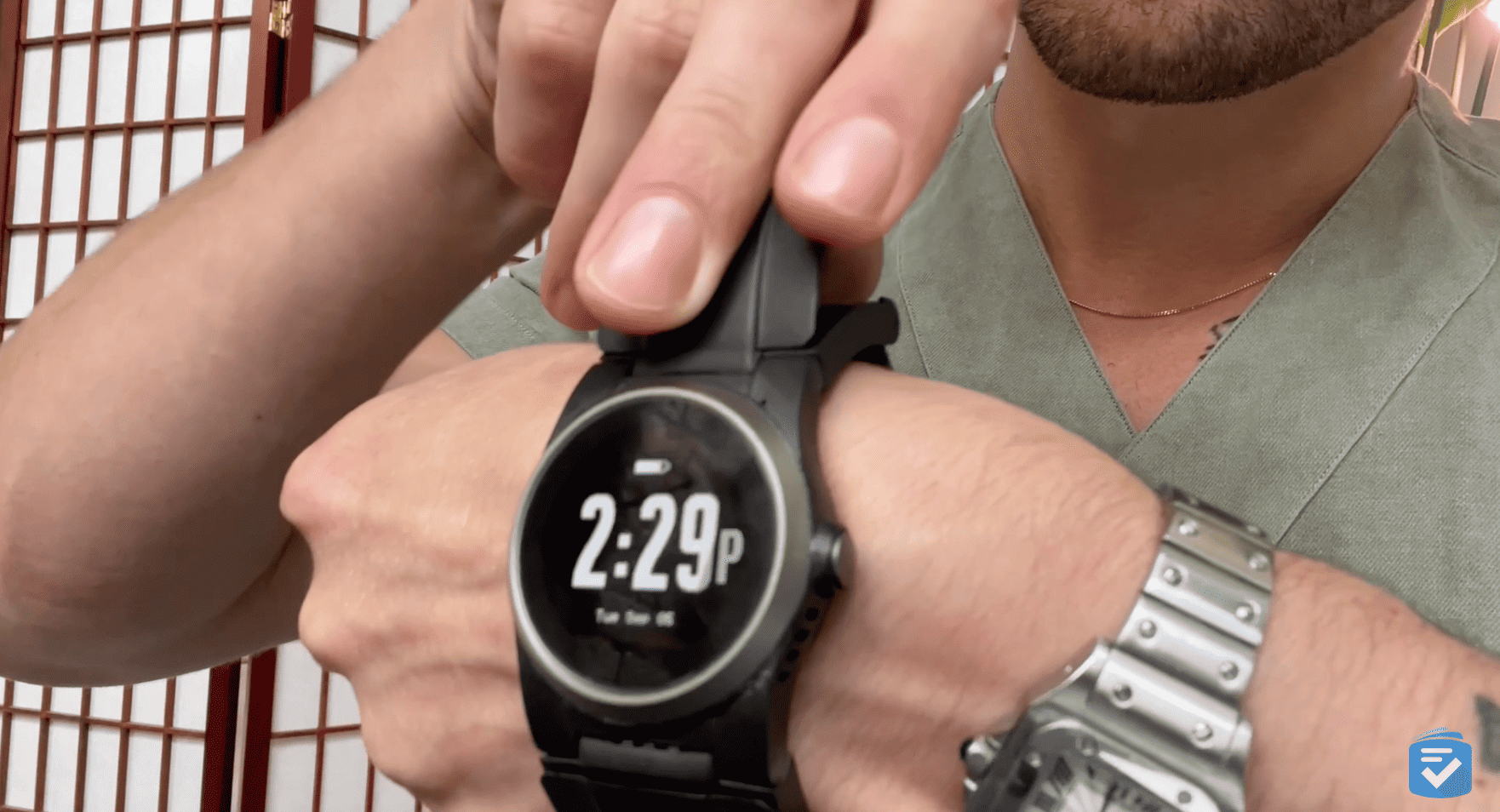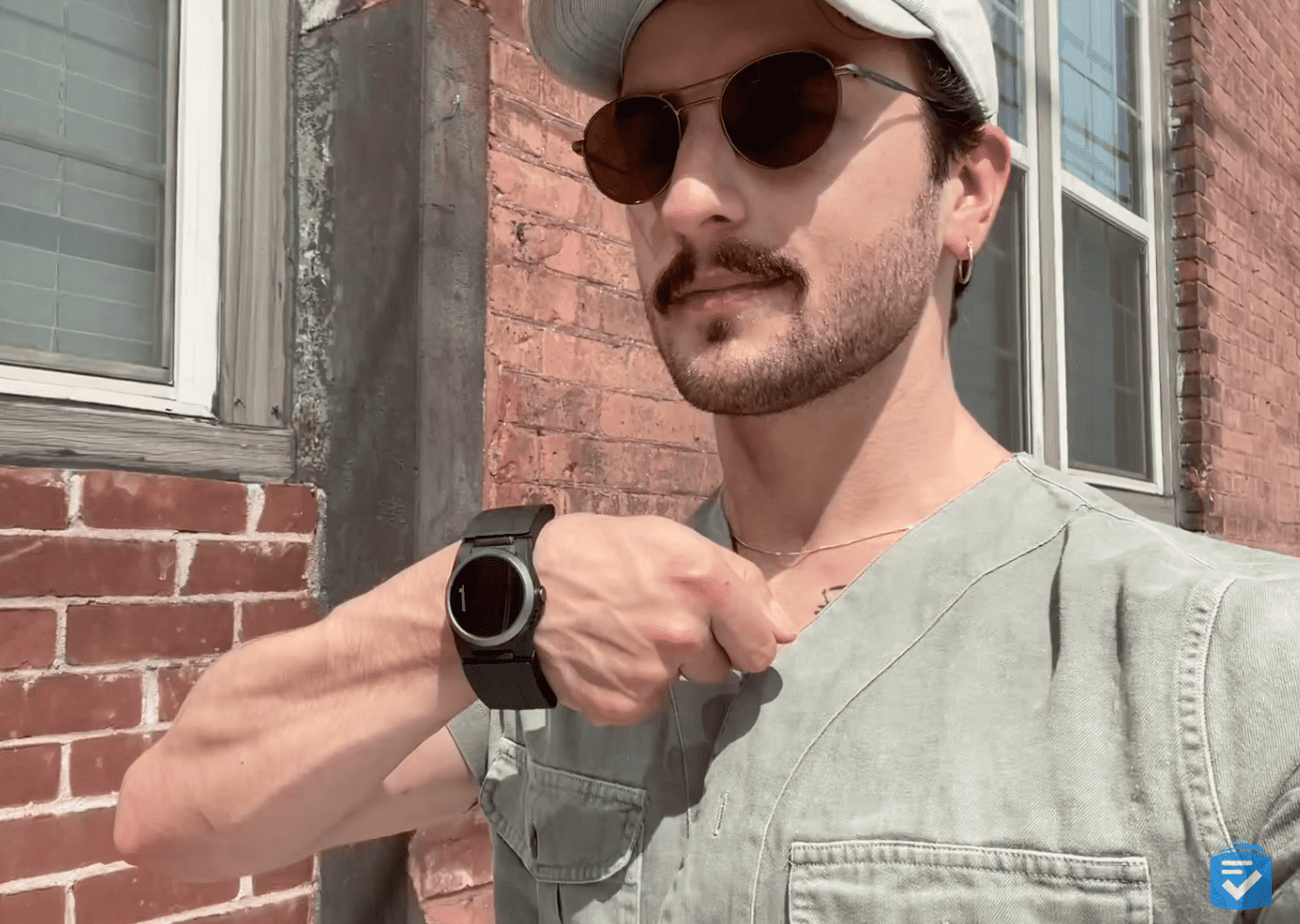


These days, medical alert watches are a standard option for most companies. Medical Guardian, Bay Alarm Medical, and MobileHelp all offer devices that combine medical alert functionality with the discreet profile of a wristwatch.
UnaliWear, a newcomer to medical alerts, aims to disrupt the smartwatch world with their stylish Kanega Watch. The Kanega Watch includes automatic fall detection — a rarity with medical alert watches — and has a unique battery system that allows for 24/7 wear. These features, however, come at a premium. The Kanega Watch costs $299 and ongoing monthly fees are $79.95, making it the single most expensive medical alert watch we’ve seen.
In this Kanega Watch review, we’ll take a closer look at UnaliWear’s foray into the smartwatch world. We’ll test all of its features – including GPS and fall detection – as well as compare it to other popular medical alert watches.
Pro Tip: Looking for medical alert protection for as low as $20 per month? Then check out our rundown of this year’s best medical alert systems for seniors.
Kanega Watch Pros and Cons

Pros
- Sleek and stylish: The Kanega Watch is a comparably stylish and discreet alternative that might appeal to people who are put off by the clunky design of typical medical alert bracelets.
- Fast response times: In our 10 test calls, the UnaliWear monitoring agents answered our distress calls in an average of 30 seconds, putting the Kanega Watch on par with other medical alert companies.
- Fall detection included: While other medical alert companies charge $10 per month for fall detection, the Kanega Watch includes this feature in your monthly subscription.
- Round-the-clock wear: The Kanega Watch includes four rechargeable batteries that charge separately from the watch, meaning a person, in theory, never has to take it off to charge it.
Cons
- High costs: There’s no way around it: The Kanega Watch is the most expensive medical alert device we’ve tested, at $299 for the watch and $80 per month for service. Paying annually lowers the monthly subscription cost to $64.95 per month, which is still on the higher end, however.
- No features for caregivers: Most medical alert watches have companion apps. These apps allow caregivers to communicate with the watch wearer or track their location. The Kanega Watch does not offer this support.
- Somewhat cheap design: The watch feels like it’s primarily made of plastic, and its low-definition screen shows visible pixelation.

Kanega Watch Specs
| Feature | Specification |
|---|---|
| Watch cost (one-time) | $299 |
| Monthly cost | $79.95 |
| Average response time | 30 seconds |
| Battery life | 32 hours |
| Water resistance | IP67 |
| GPS | Built-In |
| Fall detection | Included |
| Medication reminders | Included |

What Is the Kanega Watch?
The Kanega Watch is a medical alert watch; that is, a medical alert system designed to look like a smartwatch. When the Kanega Watch wearer uses the watch to call for help, they’ll be connected to a 24/7 U.S.-based monitoring center operator who will assess the wearer’s emergency and contact the appropriate response. In some cases, this may mean calling first responders. In non-emergency situations, it might mean calling a neighbor for help.
>> Read More: The Best Smartwatches for Seniors
Kanega Watch Video Review
Looking to see the Kanega Watch in action? Then watch our video review.
Using My Kanega Watch
After purchasing my Kanega Watch, I received an email prompting me to fill out an online setup form. This form asked for identifying information for the watch user, their address, and their emergency contacts, among other things.
This information was used to create a profile for me with their monitoring center. For example, if I placed an emergency call and didn’t need medical help, they would now have my sister’s phone number and could contact her for nonemergency situations.
Unboxing and Installation
Inside my Kanega Watch box, I found the following:
- 1 Kanega Watch
- 4 rechargeable batteries
- 1 battery charging station
- 1 charging cable
- 1 wall plug (power supply)
- 1 instruction manual
- 1 squishy toy (vaguely resembling the yellow M&M character)
To begin using the Kanega Watch, I charged the batteries by placing them in the charging station. After roughly two hours, the charging station’s lights turned green, indicating that they were fully charged and ready to be placed in the watch.
Design


At first glance, the Kanega Watch looks more or less like any other smartwatch, medical alert or otherwise. It has an adjustable strap that locks into place, a large round display screen that shows the date and time, and a button on the side.
The primary difference will be the areas above and below the watch display. These slots are where you place the batteries. Although there are two slots, you only need one battery in place for the watch to function.
Additionally, the batteries pop out easily, which I can see being very useful for those with dexterity issues.
Testing

Unlike other medical alert watches, which can be used to send text messages, count your steps, or even check the weather, the Kanega Watch has one primary feature: placing an emergency call.
>> Read More: SOS Smartwatch Review
This can be accomplished in one of three ways:
- Pressing the button
- Using your voice
- Falling
To place a call with a button, I simply pressed and held the button for two seconds. After that, the screen displayed a phone, and I heard the call being made.
To place a call with my voice, I had to say the watch’s wake word, “Fred Astaire.” After saying this, the watch displays an ear, indicating that it’s listening. From here, I could say either “Get help” or “Call the operator.” Either phrase would trigger a call to the monitoring center.

Overall, I found both of these methods useful, and my calls connected with operators in an average of 30 seconds. My one critique is that I wish the wake word could be changed. I cringe at the thought of a user experiencing some type of emergency, and they have to remember to say Fred Astaire before requesting help.
Fall Detection


On the UnaliWear website, you’ll find frequent mentions of the Kanega Watch’s fall detection capabilities. In fact, they’ve even trademarked their own proprietary RealFall™ technology that detects falls and automatically contacts the monitoring center.
In my experience, the fall detection was mostly accurate. In my 20 test falls, the watch detected 15 of them. Additionally, when I dropped the watch and it detected a fall, I could easily cancel the call by pressing the watch’s button.
>> Read More: The Best Fall Detection Devices
Kanega Watch Costs

The Kanega Watch cost me a one-time $299 to purchase the watch and a monthly fee of $69.95. In total, I paid $369.95 (plus taxes) for my first month. Since this review was published, UnaliWear has raised the monthly plan price to $79.95 per month.
These prices can be lowered (slightly) if you opt to pay for a year of service up-front. If you choose to pay annually, you’ll pay one lump sum of $1,078.40. This includes the watch ($299) and 12 months of service (lowered to $64.95 per month).
Compare this to Medical Guardian’s smartwatch, the MGMove, which costs a one-time $199 and $39.95 per month. Bay Alarm Medical’s smartwatch costs a one-time $159 and $34.95 per month.
On the positive side, the Kanega Watch comes with a price lock guarantee, meaning that your monthly subscription costs, while high, will never rise. Additionally, the Kanega Watch includes medication reminders at no extra cost.

If you’re looking for something more affordable, be sure to check out our rundown of the best affordable medical alert systems.
Refunds and Warranties
The Kanega Watch comes with a 30-day, money-back guarantee. If you’re unsatisfied with the watch, you can return it within 30 days of shipment for a full refund, save for a $75 restocking fee.

After the initial 30 days, you can’t get a refund; however, you can stop making monthly payments by returning your watch and canceling your service.
The Kanega Watch comes with a limited lifetime warranty. This will cover the replacement of the Kanega Watch if it breaks due to defects in materials or workmanship. If the user breaks the watch, UnaliWear will replace the watch once for free. Subsequent breaking of the watch will require the user to pay $199 (plus shipping) to replace the watch.
Kanega Watch vs. MGMove
| Kanega Watch | MGMove | |
|---|---|---|
| Activation cost | $299 | $199.95 |
| Monthly cost | $79.95 | $39.95 |
| Response times | ~30 seconds | ~8 seconds |
| Fall detection | Included | Not available |
| Battery | Rechargeable (external) | Rechargeable (internal) |
| Extra features |
|
|
While the Kanega Watch and MGMove Smartwatch look nearly identical, the two smartwatches differ greatly in terms of price, batteries, and additional features.
The Kanega Watch is significantly more expensive than the MGMove. Its startup costs exceed MGMove’s by $100, and its monthly monitoring costs are roughly $30 more. That said, the Kanega Watch includes fall detection at no additional cost, while MGMove does not support this feature.
Also impressive is the Kanega Watch’s ability to make an emergency call solely using your voice, while the MGMove requires you to press on its touch screen to contact an agent.
The MGMove offers many additional features, including caregiver tracking, step counting, reminders, and text messages. However, unlocking these features will cost an additional $5 per month.
To learn more about Medical Guardian’s smartwatch, read our full Medical Guardian review.
Bottom Line

While somewhat limited in features, the Kanega Watch is a solid, reliable medical alert device.
In our tests, its monitoring agents picked up the phone in an average of 30 seconds. Its fall detection was pretty accurate as was the built-in GPS. What I most appreciate about the Kanega Watch is its unique approach to batteries, allowing the user to keep using the watch while recharging its extra batteries.
Apart from its somewhat limited features, the other main drawback of the Kanega Watch would have to be its price. With an all-in initial cost of $368.95, as well as an ongoing $79.95 per month, it’s one of the most expensive medical alert devices we’ve tested.
If price is of no concern, then we’d wholeheartedly recommend this device.
Frequently Asked Questions
-
How much does the Kanega Watch cost?
The Kanega watch costs $299 for the device and $79.95 per month on the monthly plan. Paying annually slightly lowers the monthly cost.
-
Does the Kanega Watch require a smartphone?
No, the Kanega Watch operates independently of a smartphone. It has built-in cellular and GPS capabilities, allowing it to function as a stand-alone device for emergency calls and location tracking.
-
What happens if I accidentally trigger an emergency call?
If you accidentally press the help button or trigger a false fall alert, you can inform the monitoring center agent when they respond. There are no penalties for false alarms, and the agents are trained to handle these situations professionally.
-
Is the Kanega Watch water-resistant?
The Kanega Watch is water-resistant but not waterproof. It can withstand hand washing and showers but should not be submerged.
-
What's included in the monthly fee?
The $79.95 monthly fee covers 24/7 monitoring service, fall detection, GPS location tracking, and cellular connectivity. Unlike competitors, there are no add-on charges for premium features like fall detection or medication reminders.

